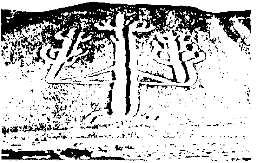 |
Science Frontiers ONLINE No. 102: Nov-Dec 1995 |
|
|
The candelabra of the andes
 595 feet from top to bottom and visible far out at sea. What was the purpose behind this strange geoglyph? |
The Pisco geoglyph really doesn't match the motifs in our books on South American archeology. Some archeologists say it is only a trident, but who ever saw a trident like this? F. Joseph, the author of the present article, thinks it looks like a Jimson weed! Furthermore, he states that there is a miniature version of the Candelabra drawn on a rock in California's Cleveland National Forest. Joseph associates the two candelabras in this way: The ancient inhabitants of Peru voyaged to California to collect Jimson weed and other hallucinatory drugs. When they sailed back to Peru with their cargo, they used the Pisco geoglyph as a navigational aid! (Joseph, Frank; "The Candelabra of the Andes," The Ancient American, 2:10, no. 10, 1995.)